ISSN ONLINE(2319-8753)PRINT(2347-6710)
ISSN ONLINE(2319-8753)PRINT(2347-6710)
Fadhel A. Hashim1, Raid K. Salim2 and Basheer H. Khudair3
|
| Related article at Pubmed, Scholar Google |
Visit for more related articles at International Journal of Innovative Research in Science, Engineering and Technology
In this work, friction stir process (FSP) was used to enhance surface properties of AA2024-T3 alloy. The effect of friction stir shoulder rotation in addition to its pressing effect on surface topography and mechanical properties was studied. Samples were FS processed with a flat pinless cylindrical shoulder of 10mm diameter with a constant rotational and travel speeds 945 rpm and 85mm/min respectively. Results show that processed layer thickness of about 45 μm was produced after FSP. Microscopic examinations (OM and SEM) revealed refining grain size of second phase particles as a result of mixing effect of the tool. XRD results show changes in the height and width of the strengthening phase θ(Al2Cu) peaks, while EDX results show that Al and Cu created at another energy (KeV) compared with those that are not in phase before FSP. The maximum hardness increment is about 40-45% and the maximum value obtained at the surface is 190Hv compared to 130Hv before processing. A little bit increase was recorded in yield and tensile strengths by an amount of 15% and 9% respectively after FSP.
Keywords |
| Friction Stir Processing (FSP), SFSP, Thermo-mechanical Processing (TMP), AA2024-T3, Al2Cu. |
INTRODUCTION |
| The strong requirement for weight reduction in aircraft and car fabrication urges for the design optimization of products employing low weight materials. Aluminum and its alloys including AA2024 (aluminum-copper alloy) are used extensively in aerospace and automotive industries because of their low density and high strength to weight ratio [1], Al-Cu alloy is a high-strength alloy in which a heterogeneous microstructure is obtained by thermo-mechanical processing (TMP) to obtain optimal mechanical properties [2]. Al2Cu is the major intermetallic in Al-Cu alloys, which imparts strength to this alloy at the same time decreasing the corrosion resistance due to the formation of galvanic cells between the noble Al2Cu and the Al matrix. Improvement of the surface properties of the aluminum alloys can be done by a variety of processes like thermo-mechanical treatment (TMT), equal-channel angular processing (ECAP), high pressure torsion (HPT), accumulative roll bonding (ARB), etc., all of which can be used to produce a fine grain size, are complex and time consuming, e.g., during TMT a solution treatment, over-aging, reducing the thickness reducing the thickness of plates, etc. and are involved, with a resultant reduction in the overall economy of the process [3]. In addition, none of these processes are capable of producing localized surface modification. So that, Friction Stir Processing (FSP) were the first to use by Mishra et al. [4] in (1999), as TMP for super-plasticity, and then was developed by Mishra et al. (2003) Microstructural modification and fabrication of matrix composites [5], and recently by Mishra and Mahoney (2004)[6] superplasticity enhancement and forming process. FSP is an emerging surface engineering technology based on the principles of Friction Stir Welding (FSW), where a nonconsumable rotating tool (with/or without pin) and shoulder is inserted into a single piece of material and traversed along the desired path to cover the region of interest. It relies on solid-state deformation. During this process, the severe plastic deformation and thermal exposure of material, results in a significant evolution in the local microstructure, also eliminates inherent defects in the starting material and thereby improves its strength, ductility, corrosion resistance, fatigue resistance. formability, and a host of other properties [7]. |
| It is worth mentioning that the development of two types of material modification has been carried out; the first, involume FSP (VFSP) is based on the full thickness modification and second the surface FSP (SFSP), or Friction Surface process as named by Ben James M. (2010) [8] is based on the modification of materials surface up to 2 mm depth [5]. Current research relies on the surface FSP (SFSP). |
| B. Zahmatkesh et al.(2010) [1]study the effect of FSP as a means to enhance the near-surface material properties of AA2024-T4, the results show that FSP was beneficial to improvement of hardness and wear resistance. XRD patterns show dissolution of CuMgAl2 particles in NZ as a result of an increase in temperature, Mg with bigger atomic radius dissolved to Al lattice and rejection of Cu with lower atomic radius and formation of Al2Cu. |
| L. Karthikeyan et al.(2011) [7]studied the effects of FSP on microstructure and mechanical properties of cast aluminum alloy of 2285 grade. Results show improved mechanical properties have been observed for all parameters. |
MATERIALS AND METHODS |
| The material used in this work is AA2024-T3 alloy with the nominal composition in wt.% shown in Table 1. The AA2024-T3 plates (250×100×5 mm in size) were friction stir processed, with a classic vertical milling machine at constant rotation and travel speeds of (945 rpm and 85 mm/min) with a non-consumable tool made of tool steel have a shoulder diameter of 10 mm without pin. The tool inserting depth was 0.25 mm in a 5 mm thick plate. |
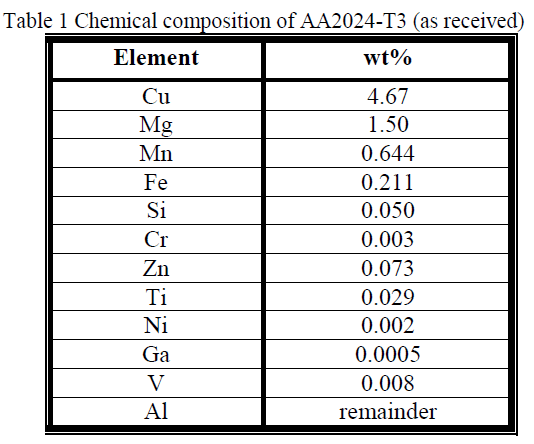 |
| The microstructural analysis of the friction stir processed samples was carried out by optical microscope and scanning electron microscope (SEM), samples were etched with Keller's reagent to reveal the grain boundaries. Microhardness measurements were carried out using (Zwick/Roell Z HV) Vicker's micro hardness tester at 50g load for 15s according to ASTM-E384. The readings were taken starting from the center of friction stirred zone near the surface, the other readings were distributed as a straight line to the left and right of the center, the interval between the neighboring measurements is 1mm, Fig. (1). Transverse tensile specimens were prepared for the base metal and friction stir processed samples according to ASTM (B557M), test was carried out by (Tinius 200 super L) computerized universal testing machine. In order to analyze the phases of the samples a Philips diffractometer (40 kV) with Cu Kα radiation (λ = 1.5406 Å) was used for X-ray diffractometry (XRD) measurements. The XRD patterns were recorded in the 2Ɵ range of 10-90˚ (step size 0.05˚ and time per step 1s). |
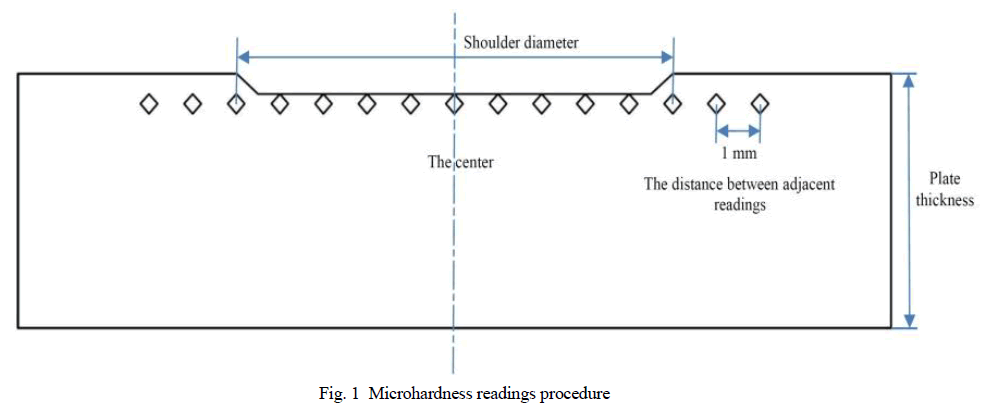 |
RESULTS AND DISCUSSION |
1. Friction Stir Processed Layer |
| The as-received aluminum 2024-T3 alloy consisting of large elongated grains with an average grain length of 192 μm and length to thickness ratio (aspect ratio) of 3.09, with large particles of precipitates distributed non-homogeneously as shown in the optical and scanning electron micrographs Figures (2) and (3). |
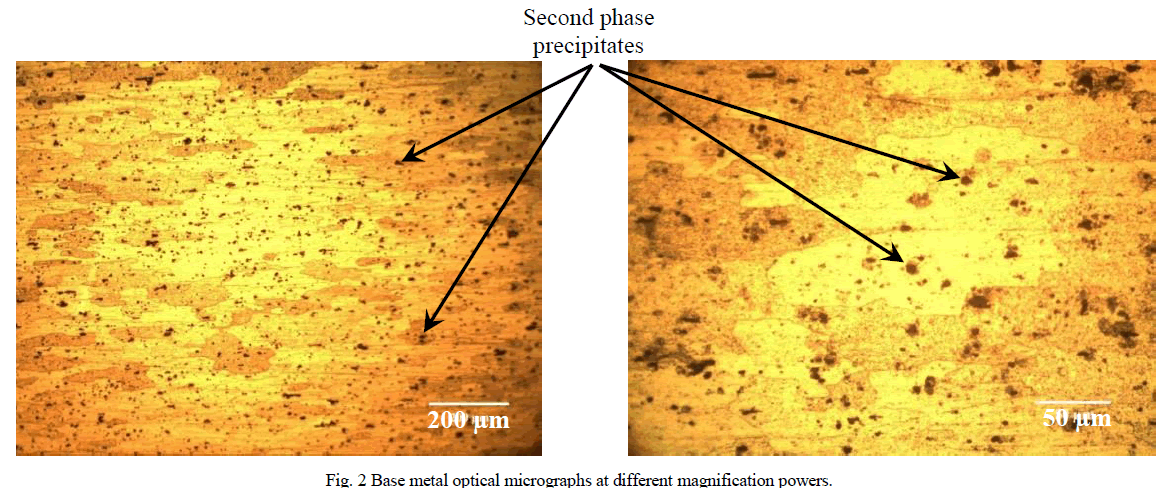 |
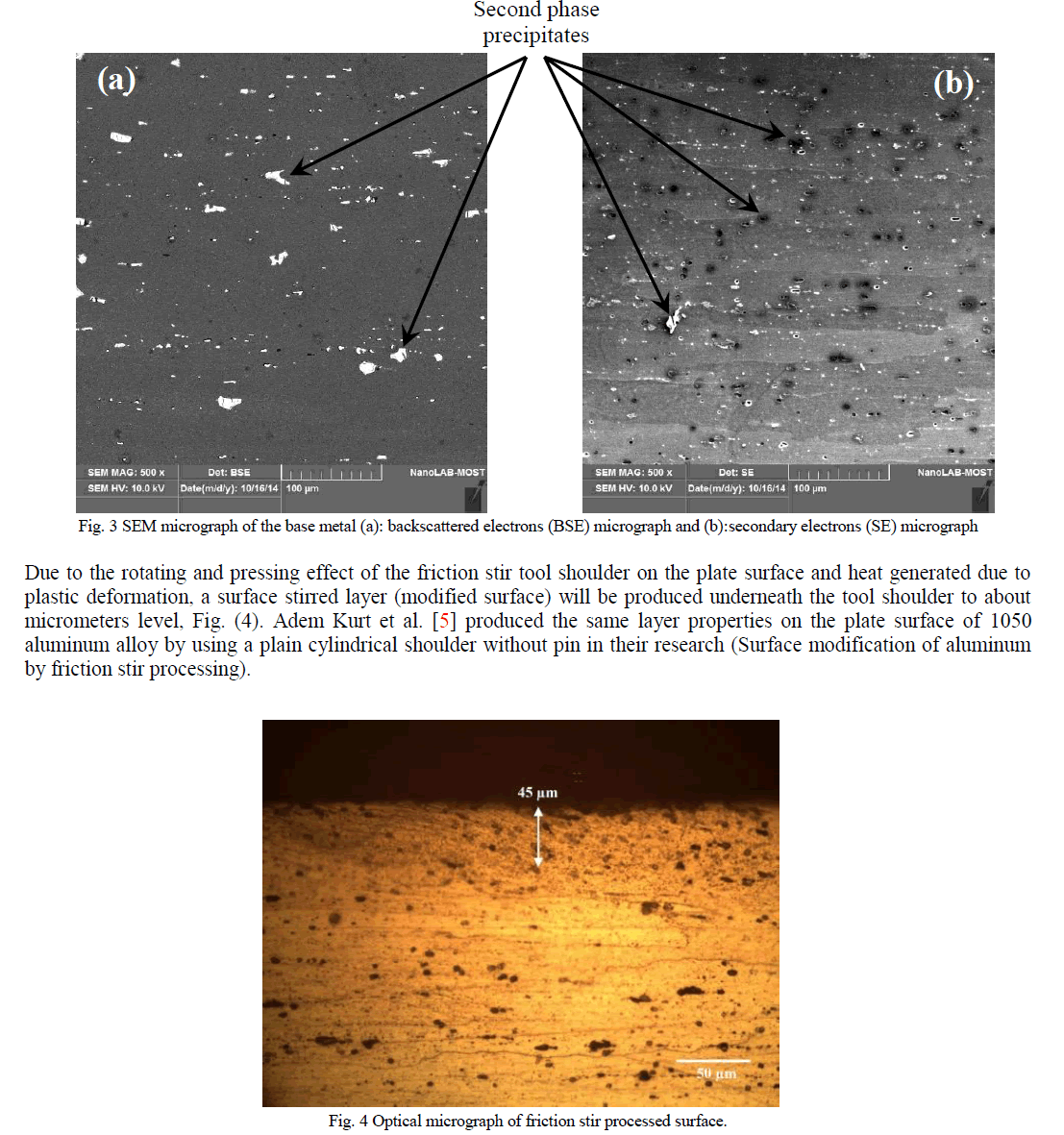 |
1. Stir Layer Characterization |
| In this manner optical microscopy technique is the main path for its simplicity. Fig. (4) shows that a layer of about 45 μm in thickness can be created in general by FSP, due to the friction temperature (about 300 ˚C according to other researches) and the strain work (or plastic work) of tool. The temperature and strain which are applied for short timedepend upon the revolution and speed of tool. The combination of temperature, strain and its period will be responsible for the creation of a new Surface layer which has a clear structure of Al2Cu as shown in XRD Fig. (5). Referring to Fig. (5), the width at half of XRD peak regarding the FSP sample is wider than that of one concerning the initial coarse-grain specimen. The peak width pertaining to crystalline grains varies inversely with their size. In other words, as the grains get smaller, their relative peaks become broader [9]. |
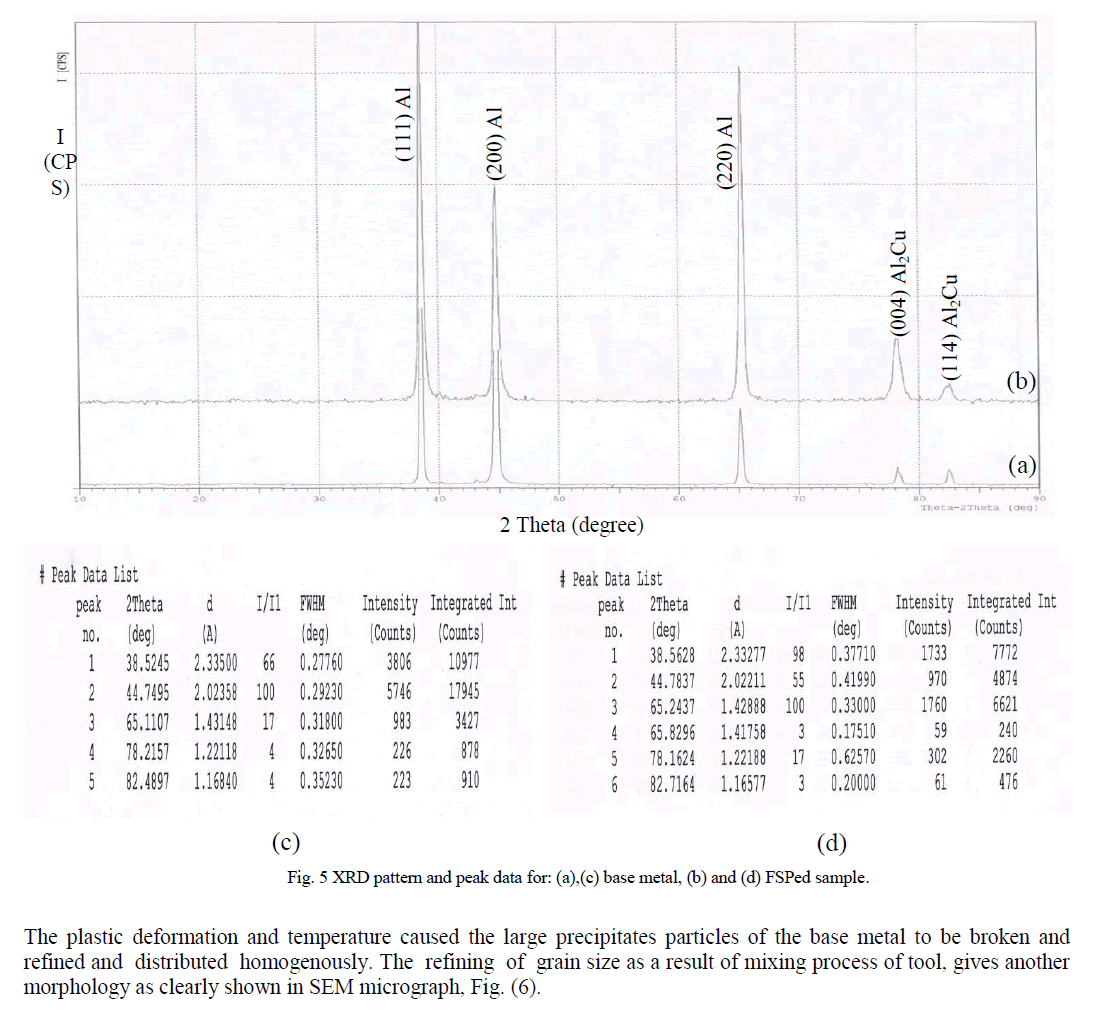 |
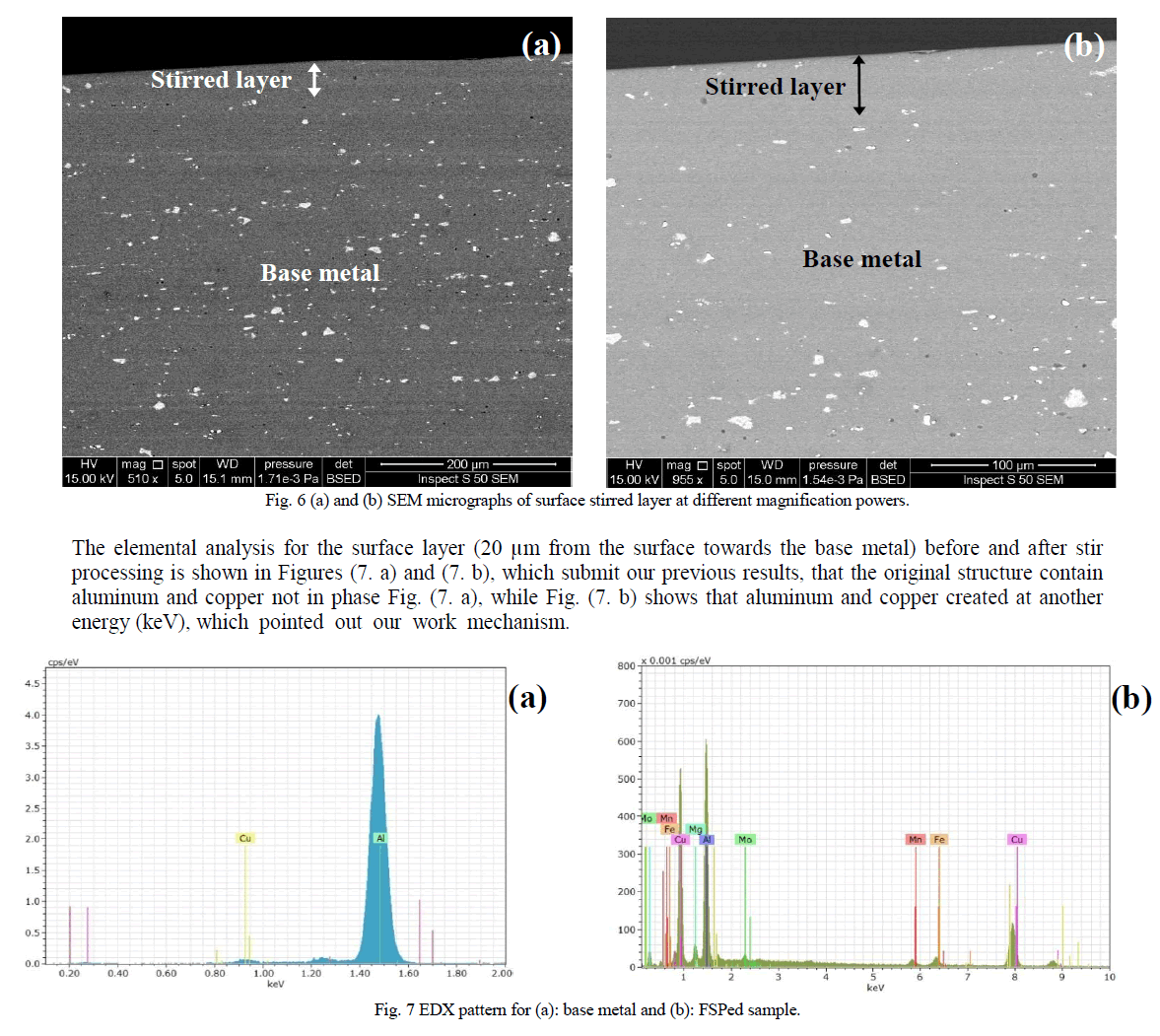 |
1. Stir Layer Mechanical Properties |
| The microhardness of stirred layer almost increases compared to that of the base metal. The maximum incremental of this property is about 40-45%. FSP with (945 rpm, 85 mm/min), increases the microhardness to about 190 HV (compared to 130 HV of the base metal), Fig. (8), which presented the microhardness profile of friction stir processed surface. |
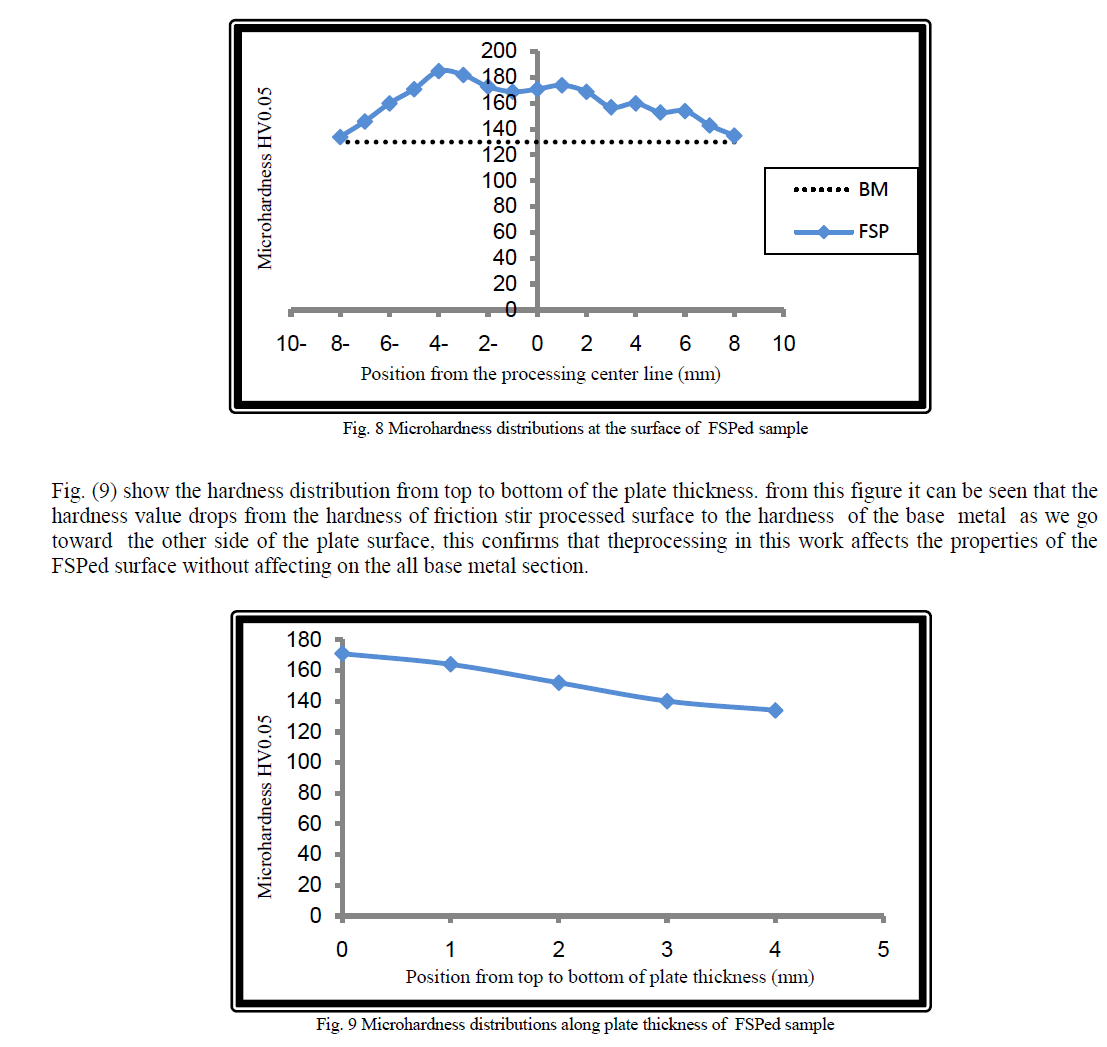 |
| The yield and tensile strengths of the base metal were 323 and 446 MPa respectively with 16% percentage of elongation, after FSP these strengths increase to 372 and 487 MPa and 17%E.which points out that the effect of FSP increases the yield strength by 15% and tensile strength by 9% compared to the base metal. Results also show that the FSP has no effect on ductility of the alloy represented by El %, so it can be concluded that the toughness of the alloy is increased somewhat since this properly depends largely on strength and ductility. |
CONCLUSION |
| 1. FSP is a complex thermomechanical process in which the combination of temperature, strain and their period are responsible for the creation of a new surface layer. |
| 2. In FSP of AA2024-T3, due to a mixing action of the tool, second phase particles are refined, so properties of the base metal are changed. |
| 3. The microhardness of stirred layer is almost increased compared to that of the base metal. The maximum incremental of this property is about 40-45%. |
| 4. The yield and tensile strengths of FSPed samples are 372 and 487 MPa, with an increment of 15% and 9% respectively. |
| 5. Toughness of the surface layer increases to some extent since its ductility is almost unchanged during FSP with the little increase in strength. |
References |
|